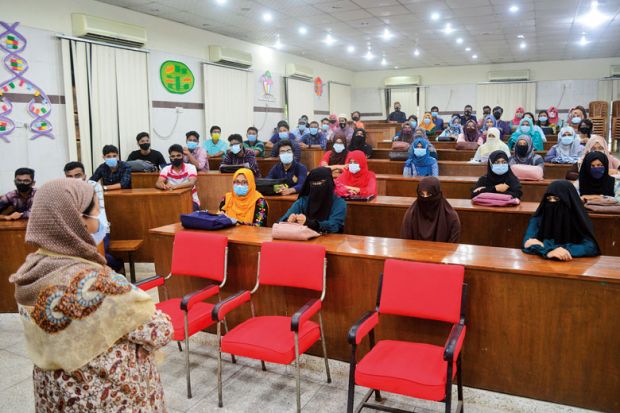Nearly three in 10 places for first-year students at Bangladeshi universities are expected to remain empty this year, according to figures from the most recent nationwide entry exams.
Just over 1 million exam takers passed the Higher Secondary Certificate and equivalent exams needed to enter university, national media reported – well below the 1.4 million available seats for first-year students at the country’s institutions. Twenty-nine per cent of places are set to lie vacant.
The most recent figures come amid a run of low-intake years for Bangladesh’s higher education providers, academics said, noting that the continued decline in student intake would strain the finances of some institutions.
Rizwanul Islam, professor of law at Bangladesh’s North South University, said the impact was likely to “strain” many private institutions.
“As there is little external funding, private universities have to rely heavily on tuition money. For public universities, tuition fees are a very nominal source of funds,” he noted.
While he predicted government-funded universities would also face lower enrolments, he said a drop in student numbers was unlikely to greatly affect their finances or force them to close.
Professor Islam attributed this year’s figures to pandemic strain on families’ budgets, with many students dropping out of school or entering jobs immediately afterwards instead of going into universities.
Nirupam Aich, an associate professor at the University of Nebraska-Lincoln who received his bachelor’s degree at the Bangladesh University of Engineering and Technology, agreed, adding that the number of students enrolling into degree courses was bound to be somewhat lower than the number of those passing the exam.
In 2020, for instance, 1.2 million students were admitted, when 1.6 million places were available – leaving a vacancy rate of 26 per cent.
“All the students who are passing the exams are not going to the bachelor’s programmes…they may end up working in jobs,” said Dr Aich.
Data published by Bangladesh’s government confirm high dropout rates for school-leavers during the pandemic. According to reports, in 2021, more than 47,400 girls in the country were married as children and some 77,700 children became labourers – and the actual figures are likely to be higher still, since the data captured results from roughly half the country’s secondary schools.
While the effects of the pandemic may be lowering the number of students taking the exam, the general pattern fits a long-lasting imbalance in secondary education between urban and rural areas, said Dr Aich.
“In the rural areas, teaching quality is not that great in many cases, which in turn reduces the number of students that can pass the exams,” he said.
He believed many universities would manage to keep operating, although with heavily reduced offerings in some cases. Some institutions would be forced to cut down their faculty members or offer only a few “specialty” courses of study – potentially perpetuating the cycle of fewer students applying.
“These universities, in fear of financial loss, don’t invest highly in providing better resources and faculty, which in turn reduces their student intake and reputation.”
Register to continue
Why register?
- Registration is free and only takes a moment
- Once registered, you can read 3 articles a month
- Sign up for our newsletter
Subscribe
Or subscribe for unlimited access to:
- Unlimited access to news, views, insights & reviews
- Digital editions
- Digital access to THE’s university and college rankings analysis
Already registered or a current subscriber? Login




